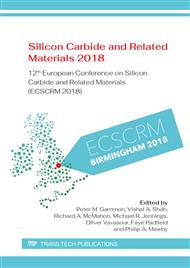p.336
p.341
p.346
p.353
p.357
p.362
p.367
p.375
p.382
Nano and Micro-Scale Simulations of Si/4H-SiC and Si/3C-SiC NN-Heterojunction Diodes
Abstract:
In the last decades, silicon carbide (SiC) based heterostructures have gained a remarkable place in research field due to their exceptional properties. These properties make SiC highly suitable for high temperature, high frequency, and high power electronics applications. The most prominent polytypes (among 200 types) of SiC like 3C-SiC, 4H-SiC and 6H-SiC, have distinctive electrical and physical attributes that make them promising candidates for high performance optoelectronic applications. Silicon (Si) also has been accepted as a promising material for wide range of electronic, optical and optoelectronic applications. Heterostructures fabricated by the direct bonding of SiC polytype and Si may have interesting physical and electrical attributes. In this paper, micro and nano-scale simulations of the nn-heterostructures of Si/4H-SiC and Si/3C-SiC have been done with Silvaco TCAD and QuantumWise Atomistix Toolkit (ATK) softwares respectively. Voltage-current density characteristics of the nanoscale and microscale simulated devices are computed and discussed. In nanoscale devices, the effects of defects due to lattice misplacements (axial displacement of bonded wafers) are also studied. These simulations are the preparation for our future experiments, which are targeted to produce either a high electron mobility diode or a light emitting diode, by direct bonding (diffusion welding) of SiC polytypes.
Info:
Periodical:
Pages:
357-361
Citation:
Online since:
July 2019
Authors:
Keywords:
Price:
Сopyright:
© 2019 Trans Tech Publications Ltd. All Rights Reserved
Share:
Citation:


